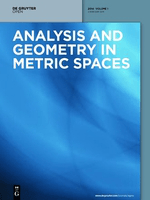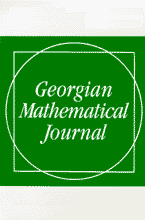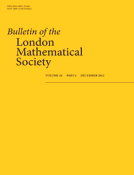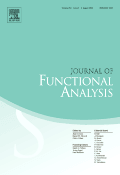
Analysis and Geometry in Metric Spaces
Scope & Guideline
Unveiling new perspectives in metric space research.
Introduction
Aims and Scopes
- Metric Geometry:
The journal emphasizes the study of geometric properties and structures arising in metric spaces, including concepts such as curvature, geodesics, and dimensionality. - Functional Analysis:
It covers the application of functional analysis techniques to problems in metric spaces, exploring topics such as Sobolev spaces and Lipschitz continuity. - Partial Differential Equations (PDEs):
The journal addresses the analysis of PDEs within metric spaces, focusing on Liouville theorems and qualitative properties of solutions. - Measure Theory and Integration:
Research on measure-theoretic aspects in metric spaces, including rectifiability and properties of measures, is a key focus area. - Variational Methods and Optimization:
The journal investigates variational problems and optimization techniques in the context of metric spaces, including minimization problems and monotone inclusions. - Geometric Analysis:
It integrates geometric methods with analytical techniques, particularly in the study of Riemannian and Finsler manifolds.
Trending and Emerging
- Anisotropic and Non-Homogeneous Spaces:
There is a growing interest in the analysis of anisotropic spaces and non-homogeneous structures, which reflects a broader trend towards understanding complex geometric configurations. - Geometric Analysis of Heat Kernels:
Research on heat kernels, particularly in relation to various geometric structures, has gained prominence, indicating an increasing focus on the interplay between analysis and geometry. - Sobolev Spaces and Regularity Theory:
The exploration of Sobolev spaces in metric contexts, particularly with respect to regularity and geometric properties, is becoming a significant theme. - Metric Measure Spaces and Curvature Bounds:
There is a notable trend towards studying metric measure spaces with curvature conditions, which has implications for both geometric analysis and PDEs. - Applications of Gromov-Hausdorff Convergence:
The application of Gromov-Hausdorff convergence in various mathematical problems is increasingly popular, highlighting its importance in understanding the structure of metric spaces.
Declining or Waning
- Classical Differential Geometry:
While still relevant, traditional topics in differential geometry are less frequently represented in recent issues, indicating a shift towards more modern approaches and applications in metric spaces. - Static Analysis Techniques:
Older techniques in static analysis that do not incorporate metric space methodologies are appearing less often, as the focus has shifted towards dynamic and more complex analyses. - Low-Dimensional Topology:
Research specifically targeting low-dimensional topology seems to be declining, with fewer papers addressing these aspects in the context of metric spaces.
Similar Journals

Collectanea Mathematica
Fostering excellence in the diverse world of mathematics.Collectanea Mathematica is a distinguished academic journal published by SPRINGER-VERLAG ITALIA SRL, dedicated to the field of mathematics, with a specific focus on both applied and theoretical aspects. Renowned for its rigorous peer-review process, the journal aims to advance knowledge in various mathematical disciplines, showcasing high-quality research that significantly contributes to the understanding of mathematical principles. With an impressive impact factor, and categorized in Q1 and Q2 quartiles for miscellaneous and applied mathematics respectively, Collectanea Mathematica plays a vital role in the academic community, catering to researchers, professionals, and students alike. The journal spans its convergence years from 2006 to 2024, reflecting a rich history of excellence and innovation in mathematical literature. With its strategic position within the Scopus rankings, it remains a pivotal resource for those seeking to stay at the forefront of mathematical research.

JOURNAL OF GEOMETRIC ANALYSIS
Fostering Excellence in Mathematical ExplorationJOURNAL OF GEOMETRIC ANALYSIS, published by SPRINGER, stands as a premier platform for the dissemination of high-quality research in the field of geometric analysis. With its ISSN 1050-6926 and E-ISSN 1559-002X, this prestigious journal has maintained a robust academic reputation since its inception in 1991, boasting a convergence of ideas and research that will continue through 2024. It is categorized in the top quartile (Q1) of Geometry and Topology, highlighting its significance and influence in the mathematical community. Ranking 23rd out of 106 in its field, and placing in the 78th percentile according to Scopus metrics, this publication is essential for researchers, professionals, and students who seek to deepen their understanding of geometric structures and their applications. Though it operates under a subscription model rather than Open Access, the journal consistently aims to advance knowledge through rigorous peer-reviewed articles that explore the latest developments and methodologies in geometric analysis, making it a pivotal resource for anyone involved in mathematical research.

JOURNAL OF DIFFERENTIAL GEOMETRY
Connecting theory and application in differential geometry.JOURNAL OF DIFFERENTIAL GEOMETRY, a premier publication by INT PRESS BOSTON, INC, has established itself as a leading forum for the dissemination of high-quality research in the fields of differential geometry, algebra, and analysis. With an impressive history that spans from 1967 to 2024, this journal is recognized for its rigorous peer-reviewed articles, contributing significantly to the advancement of mathematical theories and innovative approaches. Notably, the journal boasts a Q1 ranking in key categories such as Algebra and Number Theory, Geometry and Topology, and Analysis, reflecting its pivotal role within the mathematics community. Its Scopus rankings reinforce its reputation, placing it among the top-tier journals in its respective fields, with a 97th percentile ranking in Algebra and Number Theory, further emphasizing its influence. While the journal does not offer Open Access options, it remains a critical resource for researchers, professionals, and students aiming to stay at the forefront of developments in differential geometry and related domains. Engage with groundbreaking research and explore new methodologies that are shaping the future of mathematics.

Georgian Mathematical Journal
Unveiling the complexities of mathematics since 1994.Georgian Mathematical Journal, published by Walter de Gruyter GmbH, is a prestigious academic journal dedicated to the field of mathematics, particularly in its multifaceted applications and theoretical explorations. With an ISSN of 1072-947X and an E-ISSN of 1572-9176, this journal is indexed within notable databases and holds a strong position as evidenced by its Q2 ranking in the Mathematics (miscellaneous) category as of 2023 and a ranking of #140 out of 399 in the general mathematics Scopus category, placing it in the 65th percentile for research visibility. Since its inception in 1994, the journal has continued to evolve, aiming to foster innovative research and scholarly communication among mathematicians worldwide. Although it does not offer Open Access, the journal’s commitment to quality and rigor ensures that published works are of high relevance, appealing to researchers, educators, and students who are dedicated to advancing mathematical knowledge across diverse domains.

BULLETIN OF THE LONDON MATHEMATICAL SOCIETY
Advancing Mathematical Frontiers Since 1969The BULLETIN OF THE LONDON MATHEMATICAL SOCIETY, published by Wiley, is a distinguished journal that serves as a vital resource in the field of mathematics. With its ISSN 0024-6093 and E-ISSN 1469-2120, this journal has consistently provided a platform for innovative research and scholarly discourse since its inception in 1969. Recognized for its quality, it currently holds an impressive Q1 ranking in the mathematics category, a testament to its significance in disseminating influential findings and trends in the mathematical sciences. Researchers and practitioners can rely on the BULLETIN for its comprehensive coverage of both theoretical and applied mathematics, which caters to a diverse audience ranging from professionals to students alike. Though it does not currently offer Open Access options, its articles can be accessed through institutional subscriptions, ensuring that significant works reach the academic community effectively. With contributions that span over five decades, the journal continues to shape mathematical research and inspire future advancements in the discipline.

Pure and Applied Mathematics Quarterly
Cultivating Dialogue in the Evolving World of MathematicsPure and Applied Mathematics Quarterly is a prestigious journal published by INT PRESS BOSTON, INC, focusing on the diverse and evolving field of mathematics. Since its inception in 2007, this journal has grown significantly, currently holding a Q1 ranking in the Mathematics (Miscellaneous) category for 2023, positioning it among the leading publications in the discipline. With a commitment to publishing high-quality research, Pure and Applied Mathematics Quarterly fosters innovation and dialogue within the mathematical community by providing a platform for theoretical advancements and practical applications. The journal remains accessible to researchers and professionals through its ISSN 1558-8599 and E-ISSN 1558-8602, although it does not currently offer open access. As a vital resource for mathematicians, educators, and students, this journal endeavors to expand the frontiers of mathematical knowledge and contribute to the academic dialogue surrounding this fundamental science.

ANNALI DI MATEMATICA PURA ED APPLICATA
Pioneering Insights in Pure and Applied MathematicsANNALI DI MATEMATICA PURA ED APPLICATA is a prestigious journal published by Springer Heidelberg, focusing on the field of Applied Mathematics. With a rich history dating back to its initial publication stages from 1858, this journal continues to serve as a vital platform for researchers and professionals seeking to disseminate high-quality, peer-reviewed research. The journal's strong reputation is reflected in its Q1 ranking in Applied Mathematics and its Scopus rank of #335 out of 635, placing it in the 47th percentile, showcasing its impact in the field. Although it is not an open-access journal, it provides exclusive insights and advancements in mathematical applications, allowing academics to explore innovative methodologies and theoretical developments. The combination of its long-standing tradition and contemporary relevance makes ANNALI DI MATEMATICA PURA ED APPLICATA an essential resource for scholars and students looking to deepen their understanding of mathematics and its practical applications.

Kyungpook Mathematical Journal
Advancing Mathematical Frontiers with Every PublicationWelcome to the Kyungpook Mathematical Journal, a prominent publication dedicated to the advancement of mathematical research across various fields, including applied mathematics and miscellaneous mathematical disciplines. Published by the Department of Mathematics at Kyungpook National University in South Korea, this journal aims to disseminate high-quality original articles, fostering a deeper understanding and innovative applications of mathematical theories. With a distinguished Scopus ranking in its category, standing at Q3 in Applied Mathematics and Q3 in Mathematics (miscellaneous), it serves as a crucial platform for both emerging and renowned scholars to share their findings with a global audience. This publication is indexed in reliable databases, ensuring enhanced visibility and impact for its contributors. Even though it currently lacks open-access distribution, the journal remains an essential resource for researchers, professionals, and students looking to stay at the forefront of mathematical exploration from 2007 to 2024 and beyond. Join us in contributing to the vibrant discourse that shapes the future of mathematics.

JOURNAL OF FUNCTIONAL ANALYSIS
Advancing the Boundaries of Functional AnalysisThe JOURNAL OF FUNCTIONAL ANALYSIS, published by Academic Press Inc Elsevier Science, stands as a premier platform in the field of analysis, encompassing a broad spectrum of topics pertinent to functional analysis and its applications. With an impressive impact factor and categorized in Q1 for the year 2023, it ranks as one of the top journals in Mathematics (Analysis), placing it in the 77th percentile among its peers. This journal, founded in 1967, continues to provide researchers, professionals, and students with cutting-edge insights, rigorous publications, and a vibrant forum for scholarly discourse. The journal remains committed to advancing knowledge in the discipline and fostering an environment that encourages innovation and collaboration. Although it does not offer open access options, its high standards for publication ensure that each issue is replete with high-quality research that significantly contributes to the field. The journal's comprehensive coverage aligns well with the evolving landscape of functional analysis, making it an indispensable resource for anyone seeking to deepen their understanding and engage with current trends in this essential area of mathematics.

Tamkang Journal of Mathematics
Fostering Interdisciplinary Connections through Mathematical ResearchTamkang Journal of Mathematics, published by TAMKANG UNIVERSITY, serves as a vital platform for researchers and professionals in the fields of applied mathematics, general mathematics, and materials science. With an ISSN of 0049-2930 and an E-ISSN of 2073-9826, this journal has established itself within the academic community, particularly noted for its contributions from Taiwan. Although categorized as Q4 in Applied Mathematics and Q3 in multiple related fields according to the 2023 ranking, it maintains a solid reputation for disseminating significant research findings and innovative methodologies. Researchers can explore an array of topics within its pages, making it an excellent resource for enhancing mathematical knowledge and applications. As it converges from 2005 to 2024, the journal invites academics, professionals, and students to engage with its content and contribute to the ongoing dialogue in mathematics and its interdisciplinary applications.